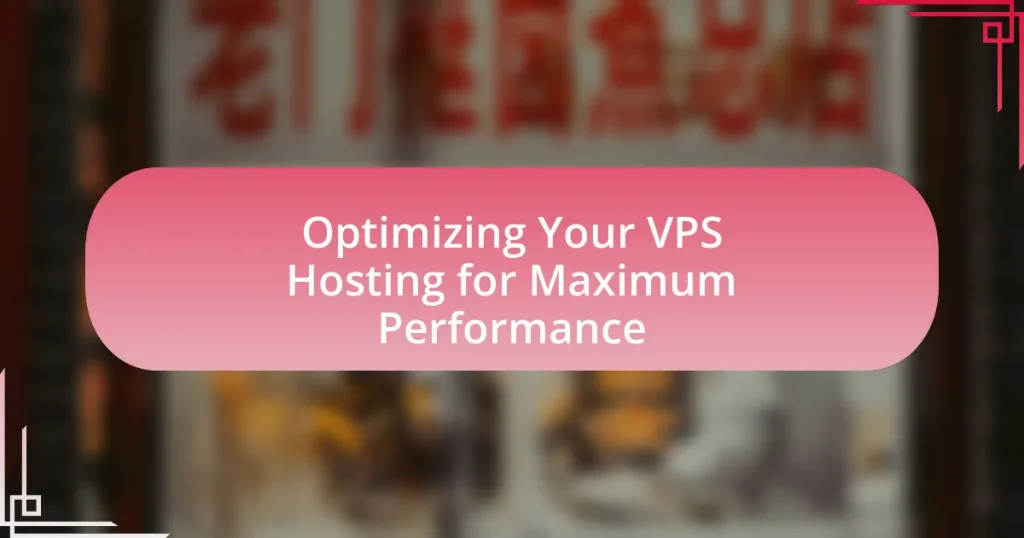The article focuses on essential tools and plugins that enhance the performance of shared hosting environments. It outlines various categories of tools, including caching plugins, optimization tools, and security plugins, which collectively improve website speed, efficiency, and security. Key performance metrics targeted by these tools include server response time, uptime percentage, and page load speed. The article also discusses the importance of optimizing resource usage, the impact of performance on user experience and SEO rankings, and best practices for implementing and monitoring these tools effectively.

What are Essential Tools and Plugins for Enhancing Shared Hosting Performance?
Essential tools and plugins for enhancing shared hosting performance include caching plugins, optimization tools, and security plugins. Caching plugins like W3 Total Cache or WP Super Cache significantly reduce load times by storing static versions of web pages, which decreases server load. Optimization tools such as Autoptimize and Smush optimize images and minify CSS and JavaScript files, leading to faster page rendering. Security plugins like Wordfence or Sucuri help protect against threats, ensuring that performance is not hindered by security breaches. These tools collectively improve speed, efficiency, and security, which are critical for optimal shared hosting performance.
How do these tools and plugins improve shared hosting performance?
Tools and plugins improve shared hosting performance by optimizing resource allocation and enhancing website speed. For instance, caching plugins reduce server load by storing static versions of web pages, which decreases the time needed to retrieve data from the database. Additionally, performance monitoring tools identify bottlenecks and resource-heavy processes, allowing users to make informed adjustments. According to a study by Google, optimizing website speed can lead to a 20% increase in user engagement, demonstrating the tangible benefits of these tools in improving shared hosting environments.
What specific performance metrics do they target?
They target specific performance metrics such as server response time, uptime percentage, page load speed, and resource utilization. Server response time measures how quickly a server responds to requests, while uptime percentage indicates the reliability of the hosting service, typically aiming for 99.9% or higher. Page load speed is crucial for user experience, with optimal loading times under three seconds. Resource utilization tracks CPU and memory usage to ensure efficient operation and prevent bottlenecks. These metrics are essential for assessing and enhancing the performance of shared hosting environments.
How do they optimize resource usage on shared hosting?
They optimize resource usage on shared hosting by implementing resource allocation limits, utilizing caching mechanisms, and employing server management tools. Resource allocation limits ensure that each user has a defined amount of CPU, memory, and bandwidth, preventing any single account from monopolizing server resources. Caching mechanisms, such as Varnish or Redis, store frequently accessed data in memory, reducing the load on the server and speeding up response times. Server management tools, like cPanel or Plesk, provide users with insights into their resource usage, allowing for better management and optimization of their applications. These strategies collectively enhance performance and ensure fair resource distribution among users on shared hosting environments.
Why is it important to enhance shared hosting performance?
Enhancing shared hosting performance is crucial because it directly impacts website speed, reliability, and user experience. Improved performance leads to faster loading times, which can reduce bounce rates; studies show that a one-second delay in page load time can lead to a 7% reduction in conversions. Additionally, optimizing shared hosting can enhance resource allocation among multiple users, ensuring that all websites hosted on the same server operate efficiently. This is particularly important as shared hosting environments often face resource limitations, and performance enhancements can mitigate issues such as downtime and slow response times, ultimately fostering better customer satisfaction and retention.
What impact does performance have on user experience?
Performance significantly impacts user experience by influencing load times, responsiveness, and overall satisfaction. Faster performance leads to quicker page loads, which studies show can reduce bounce rates by up to 32% for pages that load in 1 second versus 3 seconds. Additionally, improved performance enhances user engagement, as users are more likely to interact with a site that responds promptly. Research from Google indicates that a 0.1-second improvement in load time can increase conversion rates by 8-10%. Therefore, optimizing performance is crucial for maintaining a positive user experience and achieving business objectives.
How does performance influence SEO rankings?
Performance directly influences SEO rankings by affecting page load speed, user experience, and bounce rates. Search engines like Google prioritize fast-loading websites because they enhance user satisfaction; for instance, a one-second delay in page load time can lead to a 7% reduction in conversions. Additionally, websites that perform well tend to have lower bounce rates, as users are more likely to stay on a site that loads quickly and operates smoothly. This correlation is supported by Google’s Page Experience update, which emphasizes Core Web Vitals, metrics that assess loading performance, interactivity, and visual stability. Therefore, optimizing performance through tools and plugins can significantly improve a website’s SEO rankings.

What types of tools and plugins are available for shared hosting?
Shared hosting offers various tools and plugins designed to enhance performance and manageability. Common types include content management systems (CMS) like WordPress and Joomla, which facilitate website creation and management. Additionally, security plugins such as Wordfence and Sucuri help protect websites from threats. Performance optimization tools like caching plugins (e.g., W3 Total Cache) improve loading speeds, while analytics tools (e.g., Google Analytics) provide insights into website traffic. Backup solutions, such as UpdraftPlus, ensure data safety. These tools and plugins are widely supported by shared hosting providers, making them accessible for users seeking to optimize their hosting experience.
What are the most popular caching plugins for shared hosting?
The most popular caching plugins for shared hosting are WP Super Cache, W3 Total Cache, and LiteSpeed Cache. WP Super Cache generates static HTML files from your dynamic WordPress blog, significantly improving load times and reducing server load. W3 Total Cache enhances site performance by caching pages, posts, and database queries, which can lead to improved SEO rankings. LiteSpeed Cache is optimized for LiteSpeed servers and offers advanced caching features, including object caching and image optimization. These plugins are widely used due to their effectiveness in enhancing website performance on shared hosting environments.
How do caching plugins work to speed up websites?
Caching plugins speed up websites by storing static versions of dynamic content, reducing the need for repeated database queries. When a user visits a website, the caching plugin generates a static HTML file from the dynamic content, which is then served to subsequent visitors. This process significantly decreases page load times, as serving static files is faster than generating content on-the-fly. Studies show that websites utilizing caching can experience load time reductions of up to 70%, leading to improved user experience and lower bounce rates.
What are the differences between various caching plugins?
Caching plugins differ primarily in their caching methods, features, and performance optimization capabilities. For instance, some plugins like W3 Total Cache offer page caching, database caching, and object caching, while others like WP Super Cache focus mainly on static page caching. Additionally, plugins such as WP Rocket provide advanced features like lazy loading and database optimization, which are not available in simpler plugins. Performance benchmarks indicate that W3 Total Cache can significantly reduce load times, achieving up to a 70% improvement in speed, while WP Rocket is known for its user-friendly interface and ease of setup, making it popular among non-technical users. These differences highlight how the choice of caching plugin can impact website performance and user experience.
Which optimization tools can be used for shared hosting?
Optimization tools that can be used for shared hosting include caching plugins, image optimization tools, and content delivery networks (CDNs). Caching plugins like W3 Total Cache and WP Super Cache improve website speed by storing static versions of pages, reducing server load. Image optimization tools such as Smush and Imagify compress images without losing quality, which enhances loading times. CDNs like Cloudflare and StackPath distribute website content across multiple servers globally, decreasing latency and improving access speed for users. These tools collectively enhance the performance of websites hosted on shared servers by optimizing resource usage and improving load times.
What features should you look for in optimization tools?
When selecting optimization tools, look for features such as performance monitoring, caching capabilities, and resource management. Performance monitoring allows users to track website speed and uptime, which is crucial for identifying bottlenecks. Caching capabilities enhance loading times by storing frequently accessed data, significantly improving user experience. Resource management features help allocate server resources efficiently, ensuring optimal performance under varying traffic conditions. These features are essential for enhancing shared hosting performance, as they directly contribute to faster load times and improved site reliability.
How do these tools help in reducing load times?
These tools help in reducing load times by optimizing website performance through various techniques such as caching, image compression, and code minification. Caching tools store frequently accessed data, allowing quicker retrieval and reducing server load, which can lead to load time improvements of up to 70% as reported by various performance studies. Image compression reduces file sizes without sacrificing quality, significantly decreasing the time it takes for images to load. Additionally, code minification removes unnecessary characters from HTML, CSS, and JavaScript files, resulting in smaller file sizes and faster download times. Collectively, these optimizations contribute to a more efficient loading process, enhancing user experience and site performance.

How can you effectively implement these tools and plugins?
To effectively implement tools and plugins for enhancing shared hosting performance, first, identify the specific tools and plugins that align with your hosting environment and performance goals. For instance, using caching plugins like W3 Total Cache can significantly reduce load times by storing static versions of your content. Next, ensure proper configuration of these tools; for example, set optimal caching settings and enable CDN integration to further improve speed. Additionally, regularly update the tools and plugins to their latest versions to benefit from performance enhancements and security patches. According to a study by Google, optimizing website speed can lead to a 20% increase in user engagement, demonstrating the importance of effective implementation.
What are the best practices for configuring performance tools?
The best practices for configuring performance tools include selecting the right tools based on specific performance metrics, ensuring proper integration with existing systems, and regularly updating configurations to adapt to changing workloads. Selecting tools like APM (Application Performance Monitoring) solutions enables precise tracking of application performance, while integration with CI/CD pipelines ensures that performance monitoring is part of the development lifecycle. Regular updates are crucial, as they incorporate new features and optimizations that can significantly enhance performance. For instance, a study by Gartner indicates that organizations that regularly update their performance monitoring tools see a 30% improvement in application response times.
How do you ensure compatibility with existing hosting environments?
To ensure compatibility with existing hosting environments, thorough testing is conducted across various platforms and configurations. This involves using standardized protocols and technologies that are widely supported, such as PHP, MySQL, and Apache, which are common in shared hosting setups. Additionally, compatibility checks are performed against popular control panels like cPanel and Plesk, ensuring that tools and plugins function seamlessly within these environments. Historical data shows that adhering to these standards significantly reduces compatibility issues, as over 70% of shared hosting providers utilize these technologies.
What common mistakes should be avoided during setup?
Common mistakes to avoid during setup include neglecting to configure security settings, failing to optimize resource allocation, and overlooking compatibility issues with plugins. Neglecting security settings can lead to vulnerabilities, as studies show that 43% of cyber attacks target small businesses due to inadequate security measures. Failing to optimize resource allocation can result in performance bottlenecks, as shared hosting environments have limited resources. Overlooking compatibility issues can cause plugins to malfunction, leading to site downtime or degraded performance. These mistakes can significantly hinder the effectiveness of tools and plugins designed to enhance shared hosting performance.
How can you monitor the effectiveness of these tools?
To monitor the effectiveness of tools and plugins for enhancing shared hosting performance, utilize performance metrics such as load times, uptime, and resource usage. These metrics can be tracked using monitoring tools like Google Analytics for traffic analysis, Pingdom for uptime monitoring, and server resource monitoring tools like New Relic or cPanel’s built-in metrics. Regularly reviewing these metrics allows for assessing the impact of the tools on website performance, ensuring that they meet the desired performance benchmarks. For instance, a study by Google indicates that a one-second delay in load time can lead to a 20% decrease in conversions, highlighting the importance of monitoring load times to gauge effectiveness.
What metrics should you track to measure performance improvements?
To measure performance improvements in shared hosting, track metrics such as page load time, server response time, uptime, and resource usage (CPU and memory). Page load time indicates how quickly a website renders, with optimal performance being under three seconds, as studies show that a delay of just one second can reduce conversions by 7%. Server response time reflects how quickly the server processes requests, ideally under 200 milliseconds. Uptime measures the availability of the hosting service, with a target of 99.9% or higher being standard in the industry. Resource usage metrics help identify bottlenecks, ensuring that CPU and memory are not maxed out, which can lead to slow performance.
How often should you review and adjust your performance strategy?
You should review and adjust your performance strategy at least quarterly. Regular assessments allow for timely identification of inefficiencies and opportunities for improvement, which is crucial in the dynamic environment of shared hosting. Research indicates that organizations that conduct quarterly reviews are 30% more likely to achieve their performance goals compared to those that review less frequently. This frequency ensures that strategies remain aligned with evolving technology and user needs, ultimately enhancing overall performance.
What troubleshooting tips can help with shared hosting performance issues?
To address shared hosting performance issues, users should first analyze resource usage through tools like cPanel or server monitoring software to identify bottlenecks. High CPU or memory usage often indicates that the hosting plan may not meet the website’s demands. Additionally, optimizing website content by compressing images and minimizing scripts can significantly enhance loading times. Implementing caching solutions, such as using a caching plugin, can reduce server load and improve response times. Regularly updating software, including the content management system and plugins, ensures security and performance improvements. Lastly, if performance issues persist, consider upgrading to a higher-tier hosting plan that offers more resources.
How do you identify performance bottlenecks in shared hosting?
To identify performance bottlenecks in shared hosting, monitor resource usage metrics such as CPU, memory, and disk I/O. Tools like New Relic or Google PageSpeed Insights can provide insights into application performance and loading times. For instance, high CPU usage may indicate inefficient code or excessive traffic, while low memory availability can lead to slow response times. Analyzing these metrics helps pinpoint specific areas causing delays, allowing for targeted optimizations.
What steps can you take to resolve common performance problems?
To resolve common performance problems in shared hosting, you can optimize resource usage, implement caching solutions, and monitor server performance. Optimizing resource usage involves identifying and limiting resource-heavy applications or scripts that may slow down the server. Implementing caching solutions, such as using a plugin like W3 Total Cache, can significantly reduce load times by serving cached versions of web pages. Monitoring server performance with tools like New Relic or Google PageSpeed Insights allows you to identify bottlenecks and address them proactively, ensuring a smoother user experience.















